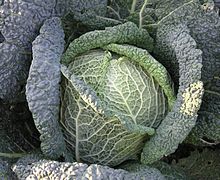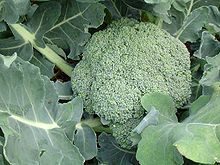Vegetable cabbage
| Vegetable cabbage | ||||||||||||
|---|---|---|---|---|---|---|---|---|---|---|---|---|

Wild cabbage ( Brassica oleracea ) on Heligoland |
||||||||||||
| Systematics | ||||||||||||
|
||||||||||||
| Scientific name | ||||||||||||
| Brassica oleracea | ||||||||||||
| L. |
Vegetable cabbage ( Brassica oleracea ) is a form-rich plant species of the genus Cabbage ( Brassica ) in the cruciferous family (Brassicaceae), whose cultivated forms include a number of vegetable cultivars.
description
The vegetable cabbage is one to two years old (cultivated forms) or perennial , herbaceous plant , which however can be woody at the base. The stature heights are 40 to 120 centimeters. The plants are protruding-sparse, but not very branched and upright. The alternate arranged on the stem leaves are often frosted wiped off blue and mostly bald. The upper stem leaves are rounded or narrowed at the base and sessile.
The hermaphrodite flowers are four-fold with a double flower envelope . The four sepals are erect. The four petals are sulfur yellow. The stamens are erect. The flowering period extends from May to September. The fruits are the typical pods for the family .
All forms and varieties have the same number of chromosomes 2n = 18. They have around 100,000 genes distributed over a genome of 599–868 Mbp (million base pairs ), and thus four to ten times as many as the model plant Arabidopsis thaliana .
ecology
The pollination is done by insects or by self-pollination . The seeds are spread by the wind, by self-propagation or by humans ( anemochory , autochory , hemerochory ).
Occurrence
The wild form is originally native to the meridional to temperate, oceanic coastal areas of Europe. It grows on rocks, partly on coastal cliffs, but also in mountains. In Germany, the wild form only occurs on Heligoland and is called "cliff cabbage" here. It grows here in the plant community Brassicetum oleraceae (Crithmo-Armerion maritimae) on the rocky slopes of the island and partly in ruderal locations that are not accessible to the sheep.
The cultivated forms are seldom found wild, except in gardens and fields, and then settle on rubble and on fresh, nutrient-rich soils .
Economical meaning
In 2018, according to the food and agriculture organization FAO, around 69 million tons of vegetable cabbage were harvested worldwide.
The following table gives an overview of the ten largest producers of vegetable cabbage worldwide, who produced a total of 78.8% of the harvest.
| rank | country | Quantity (in t ) |
|---|---|---|
| 1 |
|
33.188.664 |
| 2 |
|
9,035,000 |
| 3 |
|
2,536,675 |
| 4th |
|
2,495,839 |
| 5 |
|
1,672,000 |
| 6th |
|
1,407,932 |
| 7th |
|
1,379,545 |
| 8th |
|
1,067,590 |
| 9 |
|
985.347 |
| 10 |
|
884.846 |
| world | 69,381,553 |
The largest European producers were: Romania, Poland and Germany (604,331 t).
Systematics
Wild forms
The wild cabbage occurs in five larger, non-contiguous areas. The plants in these areas differ in terms of their morphology (height of growth, degree of branching, leaf characteristics, flower color), but can be freely crossed with one another. They are therefore listed as a species or a geographic breed, depending on the author:
- Brassica cretica Lam. occurs on coastal cliffs in southern Greece including Crete and in southwestern Turkey. It is a perennial (five to eight year old) form with branched, woody stems, fleshy leaves and pale yellow to white flowers.
- Brassica rupestris-incana complex is native to central and southern Italy with Sicily and the Dinaric Mountains . It is a heterogeneous group with the following common characteristics: large, thin, hairy leaves with a single, high, apical flower stem.
- Brassica insularis Moris in Corsica, Sardinia and Tunisia are low, branching plants with stiff, fleshy leaves and large white flowers.
- Brassica montana L. , sometimes assigned to the Brassica oleracea group, grows on the northern Mediterranean coast of Spain, France and Italy. They are shrubby, perennial plants with green, not blue-gray leaves.
- Brassica oleracea L. grows on the coastal rocks of the Atlantic from Spain to southern England and on Heligoland. The leaves are gray-green and hairless.
Cultivated forms
The many cultivated forms of vegetable cabbage are listed as varieties. A distinction is usually made (the parts of the plant used in brackets):
- Brassica oleracea var. Sabellica L. = green or kale (leaves)
- Brassica oleracea var. Medullosa Thell. = Pith stem cabbage (leaves, stem axis)
- Brassica oleracea var. Gongylodes L. = kohlrabi (thickened stem axis)
- Brassica oleracea var. Palmifolia DC. = Palm kale (leaves)
- Brassica oleracea var. Viridis L. = Kuhkohl , kale , perennials carbon (leaves)
-
Brassica oleracea convar. capitata L. = head cabbage
- Brassica oleracea convar. capitata var. alba L. = cabbage , white cabbage (leaves of the compressed shoot)
- Brassica oleracea var. Capitata fo. alba subfo. conica = pointed cabbage , pointed cabbage , filderkraut
- Brassica oleracea convar. capitata var. rubra L. = red cabbage , red cabbage (leaves of the compressed shoot)
- Brassica oleracea convar. capitata var. sabauda L. = savoy cabbage , Savoy cabbage (leaves of the compressed shoot)
- Brassica oleracea var. Costata DC. = Rib cabbage
-
Brassica oleracea var. Botrytis L. = cauliflower , cauliflower (inflorescences)
- Brassica oleracea convar. botrytis var. botrytis L. = Romanesco (inflorescences)
- Brassica oleracea var. Italica Plenck = broccoli , broccoli (inflorescences)
- Brassica oleracea var. Gemmifera DC. = Brussels sprouts , Brussels cabbage (leaves of the compressed side shoot)
- Brassica oleracea var. Ramosa (DC.) Aleph. = Shrub carbon , carbon Branched shrubs, tree carbon
Chinese cabbage ( Brassica pekinensis ) belongs to the species Brassica rapa (turnips).
Usage history
When and where the wild forms were cultivated cannot be traced. In 1980, for example, the wild Brassica cretica was grown in the fields of Samos by the locals. All wild forms and cultivated forms can be crossed with one another. The green kale can be used at least for the Greece of the 3rd century BC. As well as for Italy. In Germany it can be found in the herbal books of the 16th and 17th centuries. Kohlrabi and marrow stem cabbage are mentioned by Pliny the Elder , in Germany it can be traced back to the 16th century. The firm heads of cabbage are also only proven from this time, but should have existed as early as the time of Hildegard von Bingen in the 11th century. Broccoli and cauliflower are believed to have come from southern Greece. They probably came to France, Flanders and Germany via Genoa (around 1490). The first illustrations are from 1542. The Brussels sprouts are a very young form and originate from the 18th century, where they first appeared in Belgium.
ingredients
In addition to vitamins and minerals , such as vitamin C , vitamins of the B complex, beta-carotene , folic acid and potassium , calcium and iron , cabbage vegetables contain plenty of fiber , glucosinolates and secondary plant substances.
literature
- Udelgard Körber-Grohne: Useful Plants in Germany from Prehistory to Today . Nikol, Hamburg 1995, ISBN 3-933203-40-6 , pp. 174–192 (licensed edition).
- Rudolf Schubert , Klaus Werner, Hermann Meusel (eds.): Excursion flora for the areas of the GDR and the FRG . Founded by Werner Rothmaler. 13th edition. tape 2 : vascular plants . People and knowledge, Berlin 1987, ISBN 3-06-012539-2 .
- Siegmund Seybold (Ed.): Schmeil-Fitschen interactive . CD-ROM, version 1.1. Quelle & Meyer, Wiebelsheim 2002, ISBN 3-494-01327-6 .
Individual evidence
- ^ National Center for Biotechnology Information = NCBI - Taxonomy Browser Brassica oleracea online.
- ↑ a b Crops> Cabbages and other brassicas. In: Official FAO production statistics for 2018. fao.org, accessed on March 22, 2020 .
- ↑ a b c G. Rakow: Species Origin and Economic Importance of Brassica. In: Biotechnology in Agriculture and Forestry , Volume 54, Springer, 2004. ( Online )
Web links
- Vegetable cabbage. In: FloraWeb.de.
- Brassica oleracea L. In: Info Flora , the national data and information center for Swiss flora .
- Thomas Meyer: Data sheet with identification key and photos at Flora-de: Flora von Deutschland (old name of the website: Flowers in Swabia ).
- Brassica oleracea inthe IUCN 2013 Red List of Threatened Species . Posted by: V. Holubec, K. Uzundzhalieva, G. Vörösváry, D. Donnini, Z. Bulińska, S. Strajeru, 2010. Accessed April 27, 2014.




